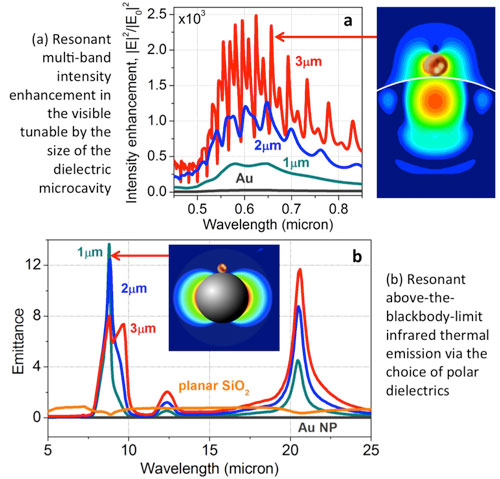| Posted: Aug 24, 2016 | |
Controlling light and heat on the nanoscale with hybrid optical-thermal antennas |
|
| (Nanowerk Spotlight) Localization of photons to nanoscale volumes with the aid of plasmonic nanoantennas opened new horizons in bio(chemical) sensing and nanoscale imaging. However, plasmon resonances are short-lived, and the photon energy quickly dissipates as heat, creating temperature gradients on plasmonic chips. | |
| While being useful for solar vapor generation, cancer treatment and catalysis, localized heating of plasmonic nanoantennas can be an undesirable effect in other applications such as sensing, imaging, spectroscopy and optical signal processing. | |
| Nanoantennas are often smaller than both the phonon mean free path in the material of the substrate on which they are located and the wavelength of thermal emission. They are also comparable in size to the mean free path distance of the air molecules. | |
| As a result, metal nanoantennas do not cool down the same way bulk materials do, and may get overheated and even melt under laser illumination. Ideal nanoantenna designs should offer significant electric field intensity enhancement, high spatial and spectral selectivity, and control over operating temperature. | |
| In new work, researchers from the Mechanical Engineering Department at Massachusetts Institute of Technology (MIT) have proposed design rules to engineer hybrid optical-thermal antennas that offer multiple functionalities in nanoscale light and heat management. | |
| Reporting their results in the August 11, 2016 online edition of ACS Photonics ("Hybrid optical-thermal antennas for enhanced light focusing and local temperature control"), the MIT team led by Dr. Svetlana V. Boriskina and Prof. Gang Chen predict that hybrid antennas made of metals and polar dielectrics can simultaneously offer orders-of-magnitude intensity enhancement at the operating wavelength and nanoscale local temperature control. | |
 |
|
| Hybrid optical-thermal antennas strongly interact with photons in both visible (a) and mid-to-far infrared (b) wavelength ranges offering opportunities for signal enhancement and temperature control. (Image: Svetlana V. Boriskina, PhD, MIT)(click on image to enlarge) | |
| Hybrid antennas can range from simple structures such as a metal nanoparticle attached to a polar dielectric microparticle to more sophisticated metal-dielectric configurations. They can be tailored to have strong resonant interactions with photons in both visible and mid-to-far infrared wavelength ranges via excitation of surface plasmon modes on metals and surface phonon-polariton modes on polar dielectrics. | |
| Localized surface plasmons are further enhanced via strong coupling and hybridization with trapped high-Q optical modes in dielectric microparticles. In turn, excitation of surface phonon-polariton modes enables hybrid antennas infrared emittance cross-sections to exceed their geometric cross-sections, resulting in enhanced passive cooling through thermal radiation. | |
| Boriskina et. al. explore different regimes of hybrid optical-thermal antenna operation that depend on the intensity of the light illumination and thermal resistances between the antennas and the rest of the optical chip. They predict that enhanced convective cooling of hybrid nanoantennas can further contribute to their temperature reduction. | |
| The authors also demonstrate how hybrid optical-thermal antennas can be used to achieve strong localized heating of nanoparticles while keeping the rest of the optical chip at low temperature, which can be useful for applications in thermal and thermally assisted catalysis. | |
| The reported results pave the way to many exciting applications of optical-thermal antennas in sensing, imaging, coherent thermal emission generation, radiative cooling and local catalysis. They also underscore the importance of multi-physics modeling of nanoantennas and of the development of new high-throughput fabrication techniques for hybrid integration. | |
|
By Dr. Svetlana V. Boriskina, MIT
|
|
|
Become a Spotlight guest author! Join our large and growing group of guest contributors. Have you just published a scientific paper or have other exciting developments to share with the nanotechnology community? Here is how to publish on nanowerk.com. |
|
